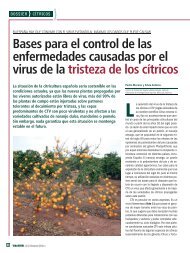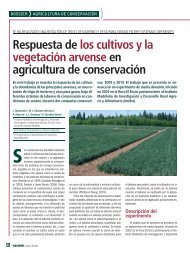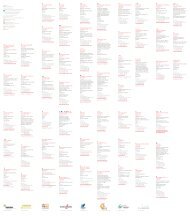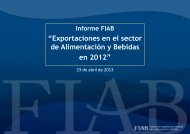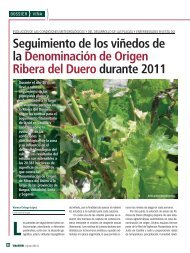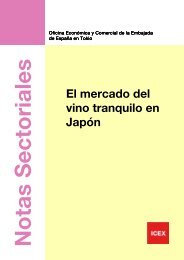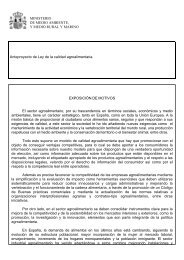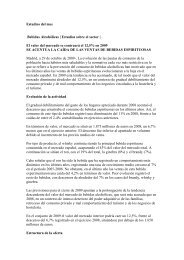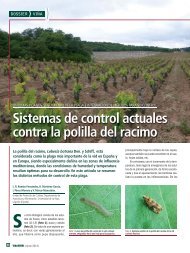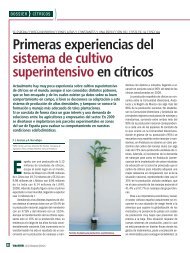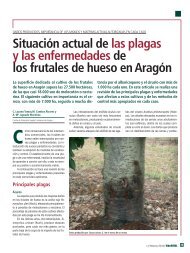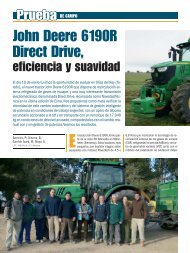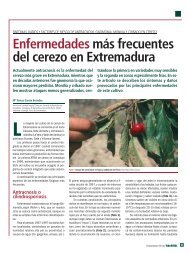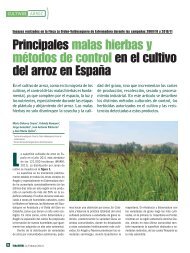Bresaola della Valtellina PGI - Eumedia
Bresaola della Valtellina PGI - Eumedia
Bresaola della Valtellina PGI - Eumedia
Create successful ePaper yourself
Turn your PDF publications into a flip-book with our unique Google optimized e-Paper software.
Meat-based products<br />
Italy<br />
<strong>Bresaola</strong> <strong>della</strong> <strong>Valtellina</strong> <strong>PGI</strong><br />
The <strong>Bresaola</strong> <strong>della</strong> <strong>Valtellina</strong> <strong>PGI</strong> is a sausage<br />
product made exclusively with the meat from the<br />
leg of cattle, between the ages of two and four years.<br />
The <strong>Bresaola</strong> <strong>della</strong> <strong>Valtellina</strong> <strong>PGI</strong> can be produced<br />
in the varieties: rump, haunch brisket, silverside,<br />
eye round and walnut.<br />
Production method: the raw matter is dry salted<br />
and left to rest in brine for a period of 10 to 15<br />
days, and then it is made into sausage in a natural<br />
<br />
to dry and mature in environmental conditions<br />
which ensure a slow and gradual reduction of the<br />
product’s humidity, and is preserved in suitably air<br />
conditioned spaces, where an appropriate change<br />
of air is assured, at a temperature between 12 and<br />
14°C. The drying and maturing process, which<br />
lasts an overall timeframe of four to eight weeks,<br />
ensures the development of the characteristics that<br />
make the product unique and matchless.<br />
the <strong>Bresaola</strong> <strong>della</strong><br />
<strong>Valtellina</strong> <strong>PGI</strong> is characterised by a uniform bright<br />
red colour, with a slightly darker rim and with a<br />
small white vein of the fat part. Its consistency<br />
<br />
taste is pleasant and moderately savoury.<br />
Production area<br />
The production area of the <strong>Bresaola</strong> <strong>della</strong> <strong>Valtellina</strong><br />
<strong>PGI</strong> is located in the entire territory of the Sondrio<br />
district, in the Lombardy region.<br />
History<br />
<br />
the <strong>Bresaola</strong> <strong>della</strong> <strong>Valtellina</strong> <strong>PGI</strong> are traced back to<br />
the 15th century, but certainly, its origins go back<br />
<br />
<br />
family circles, subsequently the artisan production<br />
<br />
product passed the national borders to be exported<br />
to close-by Switzerland.<br />
Gastronomy<br />
The whole <strong>Bresaola</strong> <strong>della</strong> <strong>Valtellina</strong> <strong>PGI</strong> is kept in<br />
cool and dry places; if sliced, it needs to be placed<br />
in the refrigerator. Generally, it is consumed fresh<br />
in thin slices, but it can also be delicious as a basis<br />
for the preparation of starters and main courses.<br />
A local traditional dish is the <strong>Bresaola</strong> <strong>della</strong><br />
74<br />
<strong>Valtellina</strong> Santa, in which the product is matched<br />
with juniper butter curls and rye bread. Another<br />
appreciated dish is the carpaccio of <strong>Bresaola</strong> <strong>della</strong><br />
<strong>Valtellina</strong> <strong>PGI</strong> served with extra-virgin olive oil,<br />
lemon, rocket and slivers of Parmigiano-Reggiano<br />
PDO. The preparation of starters - amongst which<br />
rice with <strong>Bresaola</strong> and Bitto cheese, and<br />
- is certainly also very good.<br />
Marketing<br />
The product is sold as <strong>Bresaola</strong> <strong>della</strong> <strong>Valtellina</strong><br />
<strong>PGI</strong>. It is sold whole, in pieces, vacuum-packed, in<br />
<br />
Distinctive features<br />
<br />
massaging of the meat during the preparation<br />
phase are the essential elements for the preparation<br />
of the <strong>Bresaola</strong> <strong>della</strong> <strong>Valtellina</strong> <strong>PGI</strong>.<br />
Production regions Reference Organizations<br />
Links<br />
<br />
<br />
Availability:<br />
Protected Geographical Indication (<strong>PGI</strong>)<br />
Recognized under C.R. (EC) 1263 - 01.07.1996<br />
OJEC L 163 - 02.07.1996<br />
Consorzio per la Tutela<br />
del Nome <strong>Bresaola</strong> <strong>della</strong> <strong>Valtellina</strong><br />
Via Trieste, 66 23100 – Sondrio<br />
<br />
<br />
Web: www.bresaola<strong>della</strong>valtellina.it<br />
Mail: info@bresaola<strong>della</strong>valtellina.it<br />
<br />
Qualità Agroalimentare<br />
<br />
0445313011<br />
0<br />
Web: www.csqa.it<br />
Mail: csqa@csqa.it
Fraise du Périgord <strong>PGI</strong><br />
of the variety Gariguette and Cigaline early and<br />
<br />
big; Darselect and Elsanta compact, round and<br />
with a regular shape; Mara des bois, small and<br />
<br />
big.<br />
Production method: the land, in a sunny area,<br />
must be prepared and fertilised for cultivation,<br />
must have reasonable irrigation and phytosanitary<br />
protection. Harvest is made when strawberries are<br />
<br />
<br />
October with the different species. Fruit is selected<br />
and carefully transported to the packaging plant.<br />
The fruit is stored at a maximum temperature of<br />
12ºC. Strawberries must be shipped to markets<br />
48 hours after harvest, in refrigerated lorries<br />
(6-12ºC).<br />
the Fraise du Périgord<br />
<strong>PGI</strong> is characterised by the balance of acidity and<br />
<br />
<br />
and taste.<br />
Production area<br />
The production area of the Fraise du Périgord <strong>PGI</strong>,<br />
placed at the heart of the Périgord region, known<br />
as Périgord Central, includes 32 cantons of the<br />
<br />
few cantons of the Lot department, in the Midi-<br />
Pyrenees region.<br />
History<br />
The production origins of Fraise du Périgord<br />
<strong>PGI</strong> dates back to 1895, when strawberries were<br />
cultivated between rows of vines and sold at the<br />
<br />
after the Second World War, slowly moving from<br />
production for retail to wholesale distribution,<br />
thanks to the development of transport.<br />
Gastronomy<br />
The Fraise du Périgord <strong>PGI</strong> is an extremely fragile<br />
fruit that preserves its characteristics for a few days<br />
after harvesting. Natural, with sugar or cooked,<br />
<br />
Optimum as desserts, served natural, it may be<br />
seasoned with lemon or sweet wine, together<br />
341<br />
with cream and vanilla ice-cream. It is used for<br />
<br />
and natural colouring of jams and mousse. Some<br />
recipes suggest strawberries as an ingredient in<br />
sweet-and-sour sauces which accompany game<br />
meat and roast pork meat.<br />
Marketing<br />
The product is sold as Fraise du Périgord <strong>PGI</strong> in<br />
the categories Extra or I. It is marketed packed in<br />
trays with a air bubble polyethylene bed or similar<br />
device of 500 gr and 250 gr.<br />
Distinctive features<br />
<br />
<br />
related to the presence of chestnut trees and nd<br />
vineyards in the area of production. Its historical ric<br />
fame and current reputation give them a place la<br />
in the Inventory of French Culinary heritage, g<br />
increases their demand and their value on all<br />
French markets.<br />
INDICATION GÉOGRAPHIQUE PROTEGÉE <br />
Production regions Reference Organizations<br />
Links<br />
Availability:<br />
Protected Geographical Indication (<strong>PGI</strong>)<br />
Recognized under C.R. (EC) 2400/96 - 135 - 27.01.2004<br />
OJEC L 21 - 28.01.2004<br />
<br />
<br />
UIFP<br />
Union Interprofessionnelle<br />
de la Fraise du Périgord<br />
Agropole Alphagro BP 220,<br />
F-47931 Agen Cedex 9<br />
Tel: + 33 (0) 5 53 77 21 01<br />
Fax: + 33 (0) 5 53 77 21 04<br />
Mail: contact@fraiseduperigord.com<br />
SGS-ICS,<br />
<br />
191 avenue Aristide Briand,<br />
F-94237 Cachan Cedex<br />
Tel: +33 1 41 24 89 51<br />
Fax: +33 1 41 24 89 96<br />
Fruit, Vegetables and Cereals<br />
France
Bread, pastry, cakes, confectionery, biscuits<br />
Spain<br />
Turrón de Alicante <strong>PGI</strong><br />
The Turrón de Alicante <strong>PGI</strong> is hard candy with the<br />
basic ingredients: 46% toasted almonds of “Extra”<br />
quality and 60% of the “Supreme” quality; 10%<br />
pure honey; sugar, egg whites and wafers.<br />
Production method: the Turrón de Alicante <strong>PGI</strong><br />
<br />
until it has a consistency to which the other<br />
ingredients, toasted almonds and egg white,<br />
can be added and mixed. During this phase, the<br />
mixture must be continuously stirred. At the same<br />
time, the almonds are toasted by heating them on<br />
a high heat in metal cylinders. At this point, the<br />
egg white and almonds are added and care is taken<br />
to stir the mixture by hand so as to distribute the<br />
almonds evenly.<br />
The candy is weighed while it is still hot, divided<br />
into portions and placed in moulds which hold<br />
about 6 kg and on which very thin wafers have<br />
been laid. Turrón de Alicante <strong>PGI</strong> is divided<br />
mechanically when cold and then wrapped and<br />
packed.<br />
the surface of Turrón de<br />
Alicante <strong>PGI</strong> cannot be seen as it is covered in a<br />
<br />
The centre is evenly distributed with very tasty<br />
whole toasted almonds which blend harmoniously<br />
<br />
Production area<br />
Turrón de Alicante <strong>PGI</strong> is produced in the<br />
municipality of Jijona in the province of Alicante<br />
in the Autonomous Community of Valencia.<br />
History<br />
The art of making this type of hard candy is very<br />
ancient. There are numerous references to it<br />
538<br />
dating from 1531 onwards mentioning the turrón<br />
which was introduced by the Arabs. It has grown<br />
from being a home-made sweet to the industry<br />
that it has become today.<br />
Gastronomy<br />
Turrón de Alicante <strong>PGI</strong> is not only eaten at<br />
Christmas but it is also used in other special<br />
<br />
used as the main ingredient in biscuits, cakes and<br />
desserts in general.<br />
Marketing<br />
The Turrón de Alicante <strong>PGI</strong>. It is sold in two<br />
varieties: Turrón de Alicante <strong>PGI</strong> Suprema,<br />
containing a minimum of 60% almonds and<br />
Turrón de Alicante <strong>PGI</strong> Extra, containing a<br />
minimum of 46% almonds. It is sold in individual<br />
rectangular tablets of 15 to 90 gr and in rectangular<br />
tablets of 100 to 700 gr and for the catering trade,<br />
it is available in 6-7 kg units. There is also a round<br />
version weighing from 35 to 400 gr.<br />
Distinctive features<br />
The Turrón de Alicante <strong>PGI</strong> has a hardness s and<br />
density rarely achieved in other sweets.<br />
INDICACIÒN GEOGRÀFICA PROTEGIDA<br />
Production regions Reference Organization<br />
Market imitations<br />
Links<br />
<br />
<br />
Availability:<br />
Protected Geographical Indication (<strong>PGI</strong>)<br />
Recognized under C.R. (EC) 1107 - 12.06.1996<br />
OJEC L 148 - 21.06.1996<br />
Consejo Regulador<br />
de la IGP Jijona<br />
<br />
<br />
Tel: +34 965 612446<br />
<br />
Web: www.jijona.com
Ovos Moles de Aveiro <strong>PGI</strong><br />
The Ovos Moles de Aveiro <strong>PGI</strong> is a product obtained<br />
from the addition of raw egg yolk to sugar syrup.<br />
Production method: according to authentic and<br />
unvarying local custom, the eggs are carefully cracked<br />
<br />
<br />
separator. At the same time, the sugar syrup is<br />
separately prepared; it must be heated to a point<br />
midway between thickening and forming threads.<br />
The yolks are added to the syrup once it has cooled<br />
down. The mixture is cooked at a temperature<br />
of 110 °C until obtaining a homogenous mixture.<br />
Next, the mixture is allowed to cool and rest for 24<br />
hours either in ovens or appropriate locations. The<br />
reason for this is that, at this stage, the Ovos Moles<br />
de Aveiro <strong>PGI</strong> mixture is quite sensitive to sharp<br />
changes in temperature and can all too easily adsorb<br />
extraneous aromas. The cooled mixture may be used<br />
<br />
out on trays and dried in ovens (if necessary) and<br />
may be covered in syrup, which affords additional<br />
protection against changes.<br />
the Ovos Moles de Aveiro<br />
<strong>PGI</strong> are uniform in colour, ranging from yellow to<br />
orange, shiny all over and its complex aroma is of<br />
egg yolk developing towards a characteristic odour<br />
contributed to by aromas as varied as caramel,<br />
cinnamon and nuts, as a result of the chemical<br />
reactions during cooking between the sugar and<br />
the components of the egg yolk. It is sweet, with<br />
<br />
cooking process and its consistency is creamy<br />
and somewhat thick. The communion wafer<br />
occasionally used in the commercial presentation is<br />
even colour ranging from white to cream, opaque,<br />
<br />
Production area<br />
The production area of the Ovos Moles de Aveiro<br />
<strong>PGI</strong> is limited to the municipalities bordering on<br />
the Ria de Aveiro and neighbouring lagoon areas<br />
and the municipalities in the Médio Vouga, in the<br />
Aveiro and Viseu districts.<br />
History<br />
The history of the Ovos Moles de Aveiro <strong>PGI</strong> is<br />
linked to the Aveiro typical sweets production with<br />
century old origin. The manufacture of this product<br />
originated in convents, was maintained by ladies<br />
675<br />
who had been educated in convents and who passed<br />
the secret of its manufacture from generation to<br />
generation. There are documents showing that, in<br />
1502, King Manuel I granted 10 arrobas of Madeira<br />
sugar per year to the Convent of Jesus in Aveiro<br />
for the manufacture of confectionery products in<br />
the convent, which at the time was used to help<br />
patients during their convalescence. Moreover, as<br />
early as 1856 there existed a register of reputable<br />
manufacturers of Ovos Moles de Aveiro <strong>PGI</strong>. In<br />
1888 the great Portuguese writer Eça de Queiroz<br />
mentions these sweets in Os Maias and A Capital<br />
and by the great Brazilian author Erico Veríssimo<br />
who mentions the product in Solo de Clarineta-<br />
Memórias, in 1973. Ovos Moles de Aveiro are<br />
referred in 1908 as a dessert dish for royalty.<br />
Gastronomy<br />
The Ovos Moles de Aveiro <strong>PGI</strong> are best kept at a<br />
temperature of 8-25°C which gives them a normal<br />
shelf life of 15 days.<br />
Marketing<br />
The product is sold as Ovos Moles de Aveiro <strong>PGI</strong>.<br />
It is sold packaged in the production area, in barrel<br />
containers, in bulk, with or without wafer always<br />
with documentation certifying its origin, lot<br />
number and date of manufacture.<br />
Distinctive features<br />
The temperature and the lagoon humidity of o f the<br />
Aviero region are propitious to the manufacture r of<br />
Ovos Moles de Aveiro <strong>PGI</strong> giving it the appropriate riat<br />
and long-lasting plasticity which is impossible e to<br />
reproduce outside the region.<br />
INDICAÇÃO GEOGRÀFICA PROTEGIDA<br />
Production regions Reference Organizations<br />
Links<br />
Availability:<br />
Recognized under C.R. (EC) 286 - 07.04.2009<br />
OJEC L 94 - 08.04.2009<br />
<br />
<br />
<br />
Associação dos produtores<br />
de ovos moles de Aveiro<br />
Mercado Municipal Santiago R. Ovar<br />
106 — 1o AA, ABP-3800 Aveiro<br />
Tel: +351 234428829<br />
Fax: +351 234423076<br />
Web: www.apoma.pt<br />
Mail: apoma@sapo.pt<br />
SAGILAB, Laboratório<br />
Análises Técnicas, Lda<br />
R. Aníbal Cunha, n.o 84 Loja 5<br />
P-4050-046 Porto<br />
Tel. +351 223390162<br />
Fax. +351 223390164<br />
Web: www.sagilab.com<br />
Mail: info@sagilab.com<br />
Bread, pastry, cakes, confectionery, biscuits<br />
Portugal
Cheeses<br />
Austria<br />
Gailtaler Almkäse PDO<br />
The Gailtaler Almkäse PDO is a cheese made<br />
exclusively from cow’s and goat’s milk from the<br />
pastures of Gailtal. The goat’s milk does not exceed<br />
10% of total milk.<br />
Production method: cow’s and goat’s milk from<br />
two daily milkings is used for the production of<br />
Gailtaler Almkäse PDO. During the night the milk<br />
rests and is cooled in round wooden containers at<br />
a temperature varying between 12°C and 17°C. The<br />
processing starts with the addition of the milk from<br />
the morning milking and the heating to 32°C, the<br />
temperature at which the natural rennet is added.<br />
The curd produced is then cut into cubes and then<br />
crushed into lumps. The mixture obtained is then<br />
cooked at 50-52°C, mixed for about 45 minutes and<br />
placed into moulds, where it is pressed and turned<br />
many times during the day. After a couple of days it<br />
is immersed in brine for further two or three days,<br />
until the rind forms. The maturing period lasts a<br />
minimum of seven weeks.<br />
Gailtaler Almkäse PDO<br />
has a wheel shape and a dry, hard and yellow rind.<br />
The paste has a smooth texture, with sparse evenly<br />
spaced holes, a colour tending to a straw yellow<br />
and a fresh and very pleasant taste reminiscent of<br />
mountain herbs.<br />
Production area<br />
The Gailtaler Almkäse PDO production area<br />
extends along the slopes of the mountains to the<br />
north and south of the Gail Valley in the federal<br />
<br />
of Kötschach Mauthen, Dellach, Kirchbach,<br />
Hermagor, Gitschtal, Weissensee, St. Stefan im<br />
Gail, Feistritz an der Gail and Hohenthurn.<br />
History<br />
The origins of Gailtaler Almkäse PDO are closely<br />
linked to the traditional production of cheese in<br />
the Alpine region of the Gail Valley, dating back to<br />
the 14th century. A document dated 1876 gives a<br />
detailed description of the mountain agricultural<br />
situation in the Gail valley in the middle of the 19th<br />
century. Valuable information about the reasons<br />
why the production of cheese thrived in the Gail<br />
Valley can be ascertained from this testimony,<br />
<br />
and geological areas of the Alps, weather data and<br />
the botanical species present in the area.<br />
908<br />
Gastronomy<br />
Gailtaler Almkäse PDO is preserved best in its<br />
original wrapper, making sure it is stored in a cool<br />
and dry place. It is consumed fresh, either alone or<br />
as an ingredient in appetizers and main courses,<br />
often accompanied with sliced meats. It is also<br />
used in the preparation of Gaitaler Käsetorte: the<br />
typical Gailtaler Almkäse PDO based cake that is<br />
served hot or warm.<br />
Marketing<br />
The product is sold as Gailtaler Almkäse PDO.<br />
It is marketed in a whole form or in slices that<br />
are vacuum packed or packed in a protected<br />
atmosphere.<br />
Distinctive features<br />
The unspoiled nature and the climate, , that<br />
characterize the pastures of the beautiful Gailtal G al<br />
valley, allow the development of a particular cula<br />
vegetation that affect the characteristics of the th<br />
milk that is produced and that gives the Gailtaler al<br />
Almkäse PDO its distinctiveness.<br />
GESCHÜTZTE URSPRUNGSBEZEICHNUNG <br />
GESCHÜTZTE URSPRUNGSBEZEICHNUNG <br />
Production regions Reference Organizations<br />
Links<br />
Availability:<br />
Protected Designation of Origin (PDO)<br />
Recognized under C.R. (EC) 123 - 23.01.1997<br />
OJEC L 22 - 24.01.1997<br />
PRODUCERS<br />
ORGANIZATION<br />
<br />
<br />
Verein der Gemeinschaft der<br />
<br />
Hermann Lackner 9631 Jenig 1<br />
Österreich<br />
Tel: +43 6645213505<br />
Web: www.gailtaler-almkaese.at<br />
Mail: almkaese@aon.at<br />
Der Landeshauptmann von Kärnten<br />
Amt der Kärntner Landesregierung<br />
Abt. 12 Lebensmittelaufsicht<br />
Hasnerstraße 8 A-9020 Klagenfurt<br />
Tel: +43 46353631241<br />
Fax: +43 46353631240<br />
Mail: lmi.abt12@ktn.gv.at
Bread, pastry, cakes, confectionery, biscuits<br />
Cyprus<br />
<br />
<br />
<br />
<br />
<br />
<br />
<br />
<br />
Production method: <br />
<br />
<br />
<br />
<br />
<br />
<br />
<br />
<br />
<br />
<br />
<br />
<br />
<br />
<br />
<br />
<br />
<br />
<br />
<br />
<br />
<br />
<br />
<br />
<br />
<br />
<br />
<br />
<br />
Production area<br />
<br />
<br />
<br />
History<br />
<br />
<br />
<br />
<br />
<br />
<br />
<br />
1046<br />
<br />
<br />
<br />
<br />
<br />
<br />
<br />
Marketing<br />
<br />
<br />
<br />
<br />
<br />
<br />
<br />
<br />
<br />
<br />
Distinctive features<br />
<br />
<br />
<br />
<br />
<br />
<br />
<br />
<br />
<br />
<br />
Production regions Reference Organizations<br />
Links<br />
<br />
<br />
Availability:<br />
Protected Geographical Indication (<strong>PGI</strong>)<br />
Recognized under C.R. (EC) 1485 - 14.12.2007<br />
OJEC L 330 - 15.12.2007<br />
PRODUCERS<br />
ORGANIZATION<br />
CONTROL<br />
BODY



